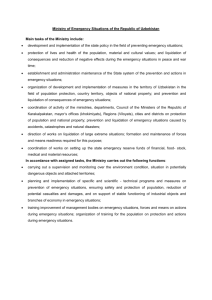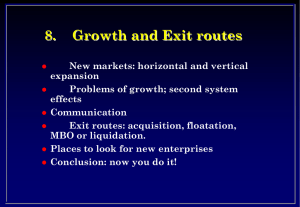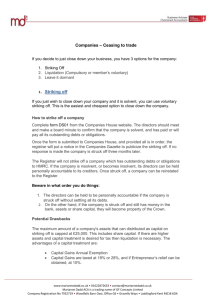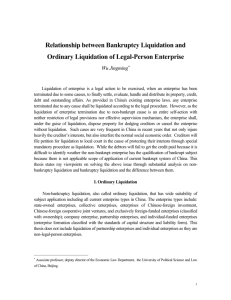Liquidations - Horizon Kinetics LLC
advertisement
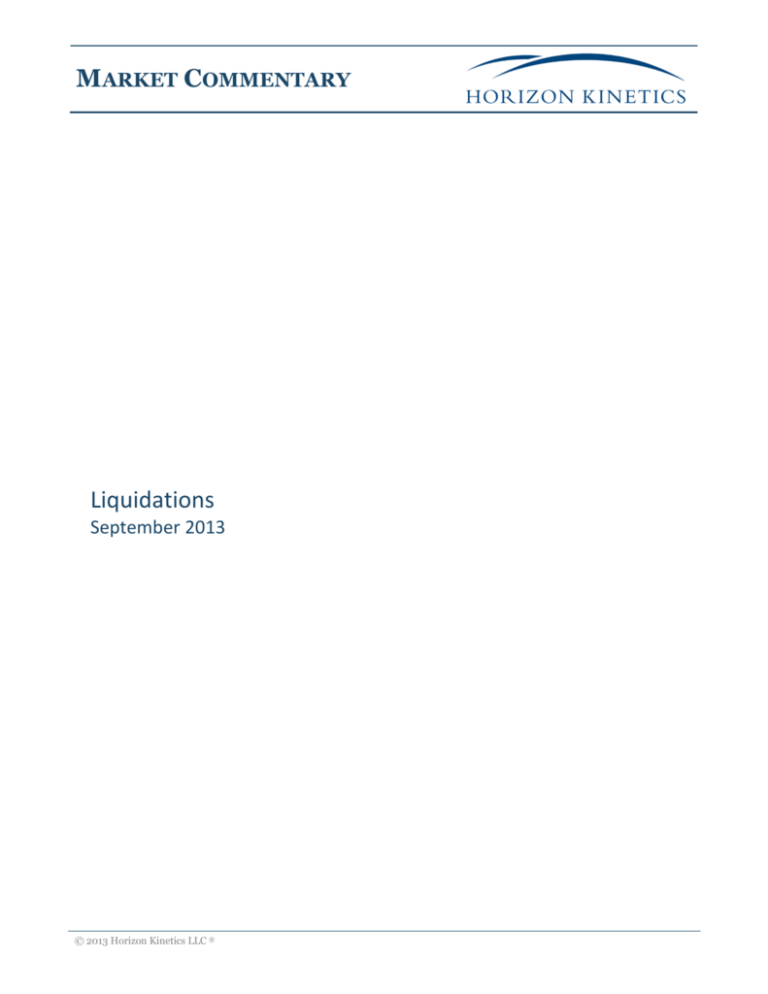
MARKET COMMENTARY Liquidations September 2013 © 2013 Horizon Kinetics LLC ® MARKET COMMENTARY September 2013 This month’s commentary concludes our series on predictive attributes with a discussion of liquidations. These are an extremely interesting type of investment, but they are incredibly rare. Defining the Asset Class A liquidation occurs when a company’s operations are brought to an end, and the assets of the company are redistributed; this may be the result of bankruptcy proceedings, but is not necessarily so. Generally, liquidations trade at a discount to their liquidation value for a host of reasons. One is simply the nature of the equity yield curve. At the end of a liquidation, the object is to have collected the maximum amount of cash. The security should then be worthless, regardless of how long it takes to liquidate. However, the pace of liquidations—and therefore the shape and length (in time) of the return curve—is unknowable. The process generally depends on either selling assets or collecting revenue under a license or royalty agreement, and then making distributions to shareholders. However, the rate of revenue collection can change for many reasons, and the inability to predict that rate generally means that a liquidation trades at a significant discount to its liquidation value. There is another reason liquidations trade at a discount to their liquidation value. The requirements of generally accepted accounting principles (GAAP) are such that, in some cases, the auditors must use liquidation accounting. This requires auditors to calculate the equivalent of a unit value for the company in liquidation, just as in a fund. It is still a company, and may still have an operating business, but it is not reinvesting its capital; therefore, it does not have a growth rate that can be reflected in its return on equity (ROE). Generally speaking, there is a tendency for these securities to trade at a discount to net asset value. When investing in a company in liquidation, the investor does not benefit from the optionality that a “normal” company might have. Just as it is possible for unfortunate events to occur, it is also possible for fortunate events to occur for a going concern. However, if a company’s only activity is the liquidation of its assets, there is little chance of a surprise, fortunate event. There may be occasions, though, when the market's initial assessment of the value of the company’s assets is wrong, and such assets prove to be more valuable to a buyer than investors had originally suspected. Nevertheless, it is not a question of what the ultimate value will be; it is a question of what the market suspects is the value. The market will see to it that the company trades at a discount to that value. Yet another factor is that when determining the present value of the company’s assets or revenues, the market will assign a discount to the sum to be collected at some rate that reflects the probability of collecting that amount of money. For example, if $100 were to be distributed in five equal $20 increments over the course of five years, a certain discount rate will be applied. If the size of the increments is unknown, however, and the market suspects there might be one big payment in the next five years, but has no idea when it might take place, a much higher discount rate will be required. There really have not been many corporate © 2013 Horizon Kinetics LLC ® 2 MARKET COMMENTARY September 2013 liquidations over the past decade but, historically, when liquidations were announced, 20% discount rates were not uncommon. In net asset value accounting, some assets are viewed as worthless because the valuation agent does not expect to collect any money. However, there are still, theoretically, possible distributions from those assets. In other words, they may prove to have value. However, the market generally ignores that possibility and pays very close attention to the value ascribed by the valuation agent. Therefore, $100 in cash to be distributed unevenly over a period of five years might initially trade at a value of $40. In that case, if an initial payment of $40 was made very early in the fiveyear period, the early rate of return would be 100%. In this example, the early distribution was more or less equal to the trading price or cost basis so, essentially, the investor has no cost basis with respect to any further distributions. How would one calculate the rate of return? One would have repatriated all the capital and the denominator might be zero, or at least very low. Clearly, a liquidation is not like a normal investment in which one buys a stock at $40, it appreciates, and the purchase price becomes the denominator for the purposes of calculating performance going forward. In the case of a liquidation, the denominator might drop and one can see how interesting it can be as an investment in a portfolio. If a large distribution is received early, the remaining investment might have very little market value and therefore pose very little, if any, portfolio risk, at least in terms of mark-to-market risk. There is always the possibility of receiving additional payments. A Brief Case History Though not current, the bankruptcy of Finova Capital (“Finova”) provides an excellent example, one that was both highly remunerative and carried very little risk, at least by our estimation. Until the discovery, in 2000, that Finova had enormous, previously undetected loan losses tied to borrowers that themselves failed in the wake of the technology bubble collapse of that era, the company had a long history as a successful, unregulated finance company. The company leased and financed a large portfolio of hard assets, such as earthmoving equipment, real estate, and jet airliners, but was unable, in that environment, to liquidate those assets with sufficient speed or at adequate prices. Accordingly, it had to file for bankruptcy protection. Among the parties that sought to acquire Finova in bankruptcy court, the successful bidder was a joint venture of Berkshire Hathaway and Leucadia National, called Berkadia, which restructured the company with a $5.6 billion loan. When Finova emerged from bankruptcy in 2001, it paid creditors cash equal to 70% of its outstanding debt, with the balance paid in the form of $3.25 billion of newly issued 7.5% new senior notes (“Notes”). Berkadia was owed almost $3 billion dollars directly and also owned $427 million of these notes, in addition to owning 51% of Finova’s common shares. The risk profile of the Notes may be summarized as follows; one might consider, while reading, whether they seem appealing: • In September 2001, following the terrorist attack on the World Trade Center, Berkshire Hathaway invoked a contingency clause in its agreement with Finova that it would not © 2013 Horizon Kinetics LLC ® 3 MARKET COMMENTARY September 2013 • • • follow through on its prior commitment to purchase $500 million additional face value of these Notes at the prescribed 70% of face value. Finova’s public accountants qualified their report on the company’s 2001 financial statements due to doubts about its ability to continue as a going concern. The company’s June 2002 financial statements included a statement that “…it is highly unlikely that there will be funds available to fully repay the outstanding principal on the New Senior Notes at maturity…”. The terms of the Berkadia loan unequivocally required that all excess cash, whether from earnings or asset sales, be applied to repayments of loan principal before any principal payments could be made on the Notes. In August 2002, Horizon’s Research Team recommended the purchase of these Notes, and indeed acquired them for client accounts; they were then trading at 30% of face value, or 30 in bond pricing parlance. However, the liquidation value of the Notes, calculated simply as the balance sheet value of the assets less the amount owed on the Berkadia loan, was 48. Thus, the upfront discount to book liquidation value was 38%. In addition, with each semi-annual coupon payment, a holder of the Notes would have 12.5% of their cost of 30 repatriated, or 25% per year. Since the early asset sales were the most marketable, the cash flows required to at least pay the initial coupons on the Notes were relatively achievable. Properly funded by Berkadia, the company proceeded to liquidate its assets in an orderly, planned fashion. It was further discovered, as is not uncommon in liquidations, that many of the assets were sold for more than their book value. This is not unexpected, since the bankruptcy process, being judicially overseen, is an inherently conservative one and assets are often written down quite severely. Accordingly, the Finova balance sheet assets were written up repeatedly as assets were sold. By June 2004, the liquidation value of the 7.5% Notes had risen to 61, and the trading price of the Notes to 56. These were not the highest figures that would be reached and, in the interim, Note holders had been repatriating, through the interest payments, 25% of their investment per year. The annualized rate of return through mid-2004 was about 64%. In fact, Finova was able to pay back the Berkadia loan two years ahead of schedule, and the company was eventually dissolved in November 2009. For those who were able to purchase the bonds and invest, basically alongside Warren Buffett, Ian Cumming, and Joseph Steinberg, the returns were substantial. Berkadia, retaining the equity, also retained Finova’s tax-loss carryforward of over $1 billion, which was an asset in which Note holders could not participate. Even in bankruptcies, liquidations are rare. There may be a restructuring in bankruptcy, but in most cases the company is not liquidated. Historically, one might see one to two liquidations per year, but there are sometimes multi-year periods in which there are no liquidations. However, bankruptcy is not the only cause for liquidations. Other examples may include royalty stream companies, where patent expirations will lead to the evaporation of revenues, © 2013 Horizon Kinetics LLC ® 4 MARKET COMMENTARY September 2013 or companies whose businesses are subject to regulations that may change, leading them to unwind in an organized fashion. As we have noted in prior commentaries, predictive attributes are often intertwined. The mere fact that a company is in liquidation would not be sufficient for it to be a viable investment. It is a signal that the security warrants closer analysis, however. In many cases, companies in liquidation may also have other predictive attributes. Owner-operators may recognize the opportunity to make a shrewd investment at a distressed valuation, as in the case of the Berkadia involvement in the Finova bankruptcy. They may be Bits and Pieces companies, which present the possibility for spin-offs that will be better received by the market. Liquidations require an extended investment horizon, and therefore are of little interest to the majority of investors. The timing of the payout, if any, is unpredictable. However, if and when it comes, it may handsomely reward the investor’s patience. DISCLAIMER Past performance is not indicative of future returns. This information should not be used as a general guide to investing or as a source of any specific investment recommendations, and makes no implied or expressed recommendations concerning the manner in which an account should or would be handled, as appropriate investment strategies depend upon specific investment guidelines and objectives. This is not an offer to sell or a solicitation to invest. This information is intended solely to report on investment strategies as reported by Horizon Kinetics LLC. Opinions and estimates offered constitute our judgment and are subject to change without notice, as are statements of financial market trends, which are based on current market conditions. Under no circumstances does the information contained within represent a recommendation to buy, hold or sell any security, and it should not be assumed that the securities transactions or holdings discussed were or will prove to be profitable. There are risks associated with purchasing and selling securities and options thereon, including the risk that you could lose money. Horizon Kinetics LLC is the parent company of several US registered investment advisers, including Horizon Asset Management LLC (“Horizon”) and Kinetics Asset Management LLC (“Kinetics”). Horizon and Kinetics manage separate accounts and pooled products that may hold certain of the securities mentioned above. For more information on Horizon Kinetics, you may visit our website at www.horizonkinetics.com. No part of this material may be: a) copied, photocopied, or duplicated in any form, by any means; or b) redistributed without Horizon Kinetics’ prior written consent. © 2013 Horizon Kinetics LLC ® 5
